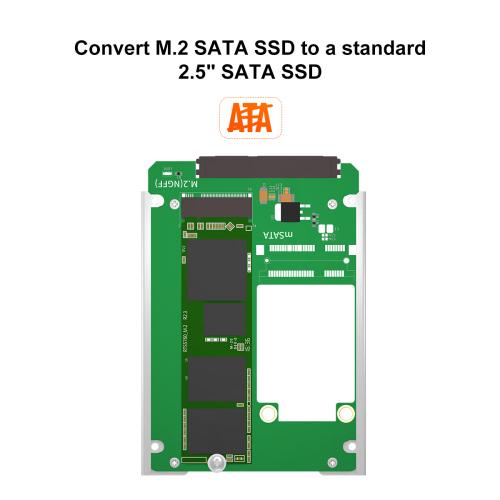Solid State Drives (SSDs) have become increasingly popular due to their speed, durability, and efficiency compared to traditional Hard Disk Drives (HDDs). However, as technology evolves, the need for SSD adapters arises to ensure compatibility with different systems and interfaces. In this article, we'll delve into the different types of SSD adapters available in the market and their significance in enhancing connectivity.

1. M.2 to SATA Adapters
M.2 SSDs are known for their compact form factor and high-speed performance. M.2 interfaces are commonly used in laptops and motherboards. However, certain systems might lack M.2 slots or only support SATA connectivity. This is where M.2 to SATA adapters come into play. These adapters allow users to connect an M.2 SSD to a SATA interface, expanding compatibility with systems that don't have native M.2 support. M.2 to SATA adapters can be particularly useful for upgrading older laptops or PCs with limited expansion options. By bridging the gap between M.2 and SATA interfaces, these adapters enable users to harness the benefits of SSD technology in a wider range of systems.
2. NVMe to PCIe Adapters
NVMe (Non-Volatile Memory Express) SSDs deliver exceptional speed and efficiency, making them the preferred choice for high-performance computing. NVMe drives typically use the PCIe (Peripheral Component Interconnect Express) interface to achieve their blazing-fast speeds. However, some systems might not have an available NVMe slot. NVMe to PCIe adapters address this issue by allowing users to connect an NVMe SSD to an available PCIe slot on the motherboard. This expansion card effectively converts the NVMe interface into a PCIe interface, ensuring compatibility with systems lacking native NVMe support. NVMe to PCIe adapters are commonly used in desktops, workstations, and servers, providing a flexible solution for integrating NVMe SSDs into a variety of setups.
3. 2.5" to 3.5" Adapters
While 2.5" SSDs are designed to fit into laptops and small form factor systems, 3.5" SSDs are used in desktops and larger enclosures. If you're upgrading a desktop that originally housed a 3.5" HDD, you might need a 2.5" to 3.5" adapter. These adapters allow you to securely mount a smaller 2.5" SSD in a standard 3.5" drive bay, ensuring a snug fit and proper connection. 2.5" to 3.5" adapters often include mounting brackets and screws to facilitate easy installation. This type of adapter is essential for ensuring compatibility when upgrading a desktop's storage solution from an HDD to an SSD without having to modify the existing drive bay.
Conclusion:
As SSD technology advances, SSD adapters usb play a crucial role in expanding compatibility and ensuring seamless integration with a variety of systems. M.2 to SATA adapters bridge the gap between different interfaces, allowing M.2 SSDs to work with systems lacking M.2 support. NVMe to PCIe adapters enable high-speed NVMe SSDs to be used in systems without native NVMe slots. Additionally, 2.5" to 3.5" adapters facilitate the upgrade of desktops from traditional HDDs to more efficient and reliable 2.5" SSDs. Each type of SSD adapter serves a specific purpose in enhancing connectivity and ensuring that SSD technology can be harnessed across various devices and configurations. By understanding these adapters and their functionalities, users can make informed decisions when upgrading or retrofitting their systems with SSDs, maximizing both performance and compatibility.